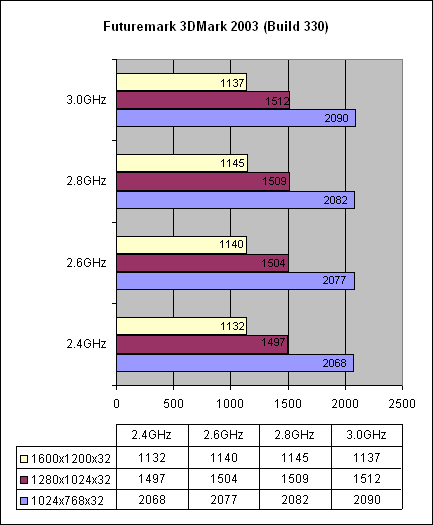Intel's New Family of 800 MHz FSB Processors
Review by Michael
Tran on 6.05.03
Managing Editor: Harry Lam
CPU Provided by Intel
Performance (Continued):
Synthetic Tests:
Futuremark 3DMark 2001 SE (Build 330):

| Processor (1024x768x32) | Score | Theoretical % | Actual % |
| 2.4GHz 800MHz FSB | 10427 | 0.0% | - |
| 2.6GHz 800MHz FSB | 10659 | 8.3% | 2.2% |
| 2.8GHz 800MHz FSB | 10893 | 16.7% | 4.5% |
| 3.0GHz 800MHz FSB | 11061 | 25.0% | 6.1% |
3DMark2001 is our first graphically intensive test that shows increases due to CPU speeds. Our results suggest that CPU speed does have an effect on our overall scores given our hardware setup. In this situation, the benchmark is CPU limited due to the linear scaling of the results. At this resolution, for every 200MHz of CPU speed, the scores approximately increase by 2-3%. In comparison to the Sandra tests, graphically intensive programs do not rely fully on the CPU. Given these linear comparisons, the actual scores show that CPU speed has a 23-27% impact on the performance of this synthetic benchmark. The remainder of the performance can be primarily attributed to the video card.
| Processor (1280x1024x32) | Score | Theoretical % | Actual % |
| 2.4GHz 800MHz FSB | 8124 | 0.0% | - |
| 2.6GHz 800MHz FSB | 8229 | 8.3% | 1.3% |
| 2.8GHz 800MHz FSB | 8305 | 16.7% | 2.2% |
| 3.0GHz 800MHz FSB | 8367 | 25.0% | 3.0% |
The next higher resolution shows a similar pattern; the results linearly increase but no where close to the theoretical yield. Notice how the increase slope has decreased by 50%. At this resolution for every 200MHz of CPU speed, the scores increase by a little less than 1%. The results also show that the CPU has an impact of about 12-15% on this test.
| Processor (1600x1200x32) | Score | Theoretical % | Actual % |
| 2.4GHz 800MHz FSB | 6201 | 0.0% | - |
| 2.6GHz 800MHz FSB | 6235 | 8.3% | 0.5% |
| 2.8GHz 800MHz FSB | 6301 | 16.7% | 1.6% |
| 3.0GHz 800MHz FSB | 6314 | 25.0% | 1.8% |
As the resolutions get higher, the slope starts to level off. The results show that the test is video card limited because the improvements are basically insignificant. As the resolutions become higher, the test become more dependent on the video card and if the results level off even further, it shows that the video card is a limiting factor. The CPU has a 5-10% impact on this test.
All three resolutions show a linear trend in the results, only differing by the slope of improvement. As the resolutions are increased, the slope gradually plateaus. Since graphical tests are primarily dependent on the video card, the video card becomes more of an important factor in overall performance as resolutions are increased. Since the slope decreases when we transition from lower to higher resolutions, the results suggest that as the benchmark becomes more intensive, the video card is pushed closer to its limits and the positive impact of an increased CPU speed is reduced.
Futuremark 3DMark 2003 (Build 330):

| Processor (1024x768x32) | Score | Theoretical % | Actual % |
| 2.4GHz 800MHz FSB | 2068 | 0.0% | - |
| 2.6GHz 800MHz FSB | 2077 | 8.3% | 0.4% |
| 2.8GHz 800MHz FSB | 2082 | 16.7% | 0.7% |
| 3.0GHz 800MHz FSB | 2090 | 25.0% | 1.1% |
The differences between CPU speeds for the 3DMark03 test are relatively insignificant. For every 200 MHz, the scores increase by 0.3%. From 2.4GHz to 3.0GHz, our score only increased by 22 points (1.1%). This is well within the standard margin of error. This test shows that the CPU has only a 4% impact during the test, suggesting that the video card is the limiting factor in this case.
| Processor (1280x1024x32) | Score | Theoretical % | Actual % |
| 2.4GHz 800MHz FSB | 1497 | 0.0% | - |
| 2.6GHz 800MHz FSB | 1504 | 8.3% | 0.5% |
| 2.8GHz 800MHz FSB | 1509 | 16.7% | 0.8% |
| 3.0GHz 800MHz FSB | 1512 | 25.0% | 1.0% |
The slope of the results of this resolution contains the same insignificant linear progression as the last resolution. Again, for every 200 MHz, the scores increase by 0.2%-0.3% and the CPU only has about 4% impact during this test. Again, the video card is the limiting factor at this resolution.
| Processor (1600x1200x32) | Score | Theoretical % | Actual % |
| 2.4GHz 800MHz FSB | 1132 | 0.0% | - |
| 2.6GHz 800MHz FSB | 1140 | 8.3% | 0.7% |
| 2.8GHz 800MHz FSB | 1145 | 16.7% | 1.1% |
| 3.0GHz 800MHz FSB | 1137 | 25.0% | 0.4% |
These results are indistinguishable between the CPU speeds, with results that are well within the standard margin of error. The sores increase from 2.4GHz and peak 2.6 and 2.8, but drop at 3.0. Since we could not get stable results after several tests, we can conclude that there are no differences in performance at all between these CPU speeds. As expected, the video card is the limiting factor.
| « Previous Page | Next Page » |

